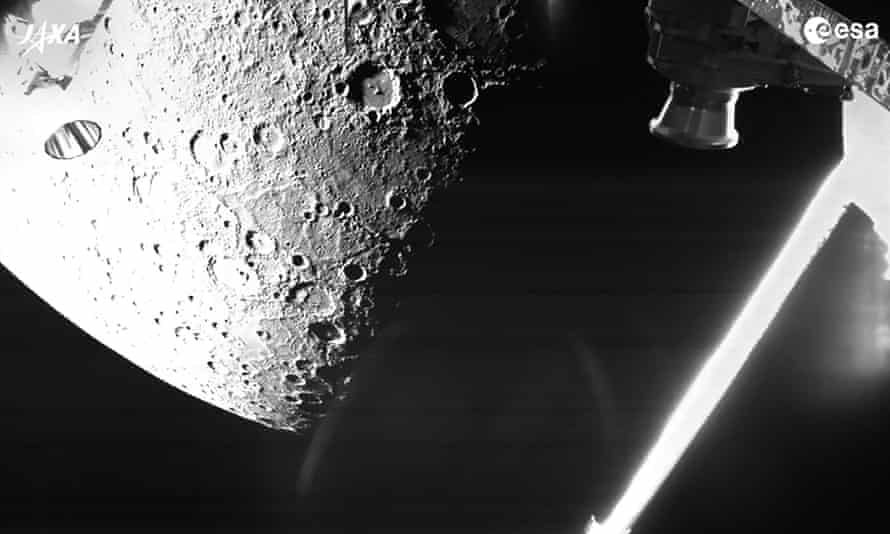欧日合作探测计划 飞行近3年传回水星首批影像
中央社
10/02/2021

欧洲太空总署(ESA)今天发表声明说,欧洲和日本合作的水星探测太空船「贝皮可伦坡号」(BepiColombo)已传回首批水星影像,水星是最靠近太阳的行星。
贝皮可伦坡号于2018年10月20日由阿利安5型火箭(Ariane 5)搭载发射升空后,展开90亿公里、长达7年漫长航程,这也是人类第3度探索水星。
水星是太阳系中距离太阳最近、体积最小的行星,太空船无法从地球直飞水星,为避免被太阳强大引力卷入,必须采椭圆形路径航行,贝皮可伦坡号此前已飞越地球1次和飞越金星2次,加上6次飞越水星,借由星球引力助推并控制航向,预计2025年12月5日抵达水星轨道,届时将释出两具探测器,从不同轨道探测水星的表面与磁场。
这是历经将近3年后第一次飞越水星并传回首批水星影像。声明表示,贝皮可伦坡号配备的相机提供黑白影像。贝皮可伦坡号1日进行6次飞越水星的第一次飞越,利用水星的引力让太空船减速,飞越高度为距水星上空199公里,并利用其中一部相机拍摄低分辨率黑白照片。
由于贝皮可伦坡号抵达水星的夜侧,不是拍摄的理想条件。影像显示地区是水星北半球的一部分,包括巨大撞击坑和数十亿年前被岩浆淹没地区。
太空船探测任务经理蒙塔尼翁(Elsa Montagnon)表示,「就太空船观点而言,这次飞越毫无瑕疵,终于能见我们的目标行星,令人难以置信。」
欧洲太空总署表示,贝皮可伦坡号的探测任务将研究水星的所有层面奥秘,从水星内核至其表面、磁场以及外逸层,以深入了解这颗最靠近太阳行星的起源和演化。
水星是除了地球之外,唯一拥有磁场的绕太阳运行岩石行星。磁场是由液体内核产生,由于水星体积较小,水星的内核如今应该已经冷却和固化,如同火星般。
水星的表面呈现极端现象,白天温度高达华氏约806,夜间则为超冰冻的华氏零下292度。
欧洲太空总署和日本宇宙航空研究开发机构(JAXA)合作的此水星探测计划,包含两具轨道探测器:ESA的水星行星轨道探测器(Mercury Planetary Orbiter, MPO)与JAXA的水星磁层轨道探测器(Mercury Magnetospheric Orbiter, MMO)。这项探测任务是以意大利科学家贝皮可伦坡(Giuseppe ‘Bepi’ Colombo)命名。
BepiColombo spacecraft sends its first images of Mercury during flyby
European-Japanese probe swoops in to almost 200km above Sun’s nearest planet, photographing its pock-marked features
10/02/2021

The European-Japanese BepiColombo spacecraft has sent back its first images of Mercury, as it swung by the solar system’s innermost planet while on a mission to deliver two probes into orbit in 2025.
The mission made the first of six flybys of Mercury at 11.34pm GMT on Friday, using the planet’s gravity to slow the spacecraft down.
After swooping past Mercury at altitudes of under 200km (125 miles), the spacecraft took a low-resolution black-and-white photo with one of its monitoring cameras before zipping off again.
The European Space Agency said the captured image shows the northern hemisphere and Mercury’s characteristic pock-marked features – among them the 166km-wide Lermontov crater.

“The flyby was flawless from the spacecraft point of view, and it’s incredible to finally see our target planet,” said Elsa Montagnon, the spacecraft operations manager for the mission.
The BepiColombo mission will study all aspects of this mysterious inner planet from its core to surface processes, magnetic field and exosphere, “to better understand the origin and evolution of a planet close to its parent star”, Esa said.
Mercury is the only rocky planet orbiting the Sun beside our own to have a magnetic field. Magnetic fields are generated by a liquid core but given its size, Mercury’s should have grown cold and solid by now, as Mars did.
This anomaly might be due to some feature of the core’s composition, something BepiColombo’s instruments will measure with much greater precision than has been possible so far.
The joint mission by the European agency and the Japan Aerospace Exploration Agency was launched in 2018, flying once past Earth and twice past Venus on its journey to the solar system’s smallest planet.
Five further flybys are needed before BepiColombo is sufficiently slowed down to release Esa’s Mercury Planetary Orbiter and Jaxa’s Mercury Magnetospheric Orbiter. The two probes will study Mercury’s core and processes on its surface, as well as its magnetic sphere.
The mission is named after Italian scientist Giuseppe “Bepi” Colombo, who is credited with helping develop the gravity assist manoeuvre that Nasa’s Mariner 10 first used when it flew to Mercury in 1974.




